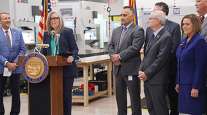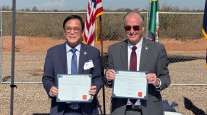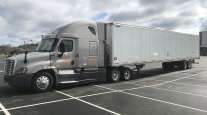Staff Reporter
Planning Group Launches Truck Parking Survey for Phoenix Region

[Stay on top of transportation news: Get TTNews in your inbox.]
An organization representing the Phoenix metropolitan area is conducting a study of truck parking issues in the region.
The Maricopa Association of Governments, which serves as the metropolitan planning organization for transportation in Maricopa County, designed the survey to gauge truck parking supply and demand in the region.
The survey asks participants how often they park in the Phoenix area, their reason for needing parking, how much time they spend looking for parking and where they park if they can’t find an appropriate truck parking space. It also asks respondents what issues they encounter that impact truck parking, such as loading delays, congestion and hours-of-service regulations.
The online survey has five parts. (Maricopa Association of Governments)
The survey, launched Aug. 10, is available through Sept. 2.
“The audience that we’re really looking to attract are the longhaul truckers,” said Tim Strow, director of transportation policy and planning at the Maricopa Association of Governments. “We wanted to make sure that the survey was open for at least three weeks to give the trucking community plenty of time to take the survey. We know how busy everybody is and the impacts of COVID are taking [their] toll on the industry and everyone else.”
Truck parking is an important issue for the industry, ranking No. 5 on the American Transportation Research Institute’s Top Industry Issues report. In order to comply with HOS rules, a driver may resort to parking in an unsafe location.
“Inadequate truck parking results in truck drivers parking on highway shoulders, ramps, vacant property or local surface streets,” said Arizona Department of Transportation Planning Manager Charla Glendening. “These parking behaviors can negatively affect highway safety, infrastructure condition and quality of life.”
The study is meant to help craft recommendations to address truck parking needs and safe solutions for drivers and community members. A plan that will serve as a road map for future truck parking solutions is scheduled to be completed in spring 2021.
Strow said the Maricopa Association of Governments also plans to conduct a subsequent survey for county residents, including those who live near industrial centers, to get their input on truck parking issues in the area.
Maricopa County has six rest areas and 19 truck stops, according to Strow. He approximates these facilities offer 2,200 truck parking spaces, although he acknowledged his team is still analyzing exact figures. Strow said about 25,000 trucks call on Maricopa County to deliver or pick up goods every day.

Connectivity is changing trucking today and into the future, including how it could enable electric and self-driving trucks. Host Seth Clevenger talks with two experts from Penske Transportation Solutions, Bill Combs and Samantha Thompson. Hear a snippet, above, and get the full program by going to RoadSigns.TTNews.com.
“It’s really, really important for us to have a plan moving forward for truck parking,” Strow said.
Encompassing cities such as Phoenix, Scottsdale and Mesa, Maricopa County is a rapidly growing area. According to the U.S. Census Bureau, the county’s population was 4.4 million in 2019, a 17.5% increase from 2010 figures.
Phoenix, which sits at the nexus of interstates 10 and 17, is an important place for freight movement. According to ADOT’s State Freight Plan, the greatest concentration of freight clusters in the state is located along the I-10 corridor in Phoenix and Tucson. The freight plan notes that, of the freight traveling to, from or within Arizona, over 83% travels by truck.
Strow described the I-10 corridor as the spine of the Phoenix metro area that serves as an “economic lifeline.” He said I-10 provides an important conduit for freight coming from the ports of Los Angeles and Long Beach and helps facilitate trade with Mexico.
“Maricopa County is one of the fastest growing counties in the United States,” Strow said. “That’s a lot of people to add to our county, and that’s a lot of goods that need to be brought in to accommodate them moving here. We anticipate that footprint and that trend of industrial development to continue.”
Want more news? Listen to today's daily briefing:
Subscribe: Apple Podcasts | Spotify | Amazon Alexa | Google Assistant | More





